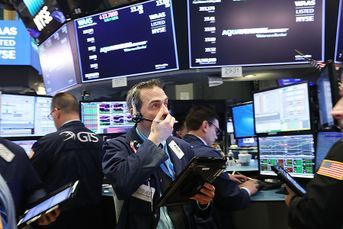Your client’s strategy might be all wet
My New York friends have a lot of umbrellas – probably more umbrellas than those owned by people…
My New York friends have a lot of umbrellas – probably more umbrellas than those owned by people in any city I know. New Yorkers have so many umbrellas because they bought them from umbrella vendors who appear like magic every time the rain starts in Manhattan.
Because New York weather is usually pretty good, hundreds of thousands of people – maybe millions – take a chance every day and leave the brolly at home. After all, it’s a hassle to carry when you have a coffee in one hand and a briefcase in the other. Comfort of the present reality wins out over protecting against a possible discomfort in the future. And if you guess wrong, there’s always the umbrella guy to save the day. The result of this failure to plan? Ruined suits and a collection of cheap umbrellas.
I think investors are like New York residents in that they continue to believe in sunny days. Like the commuter who doesn’t check the weather before leaving home, investors don’t consider the state of the markets in which they invest before plunging in with both feet. Such carefree folk poured billions into stocks in early 2000 – even as storm clouds were gathering over the tech sector. And even after drowning their portfolios, many of these same investors are now rushing back in, throwing caution to the winds as though the storm, once past, will not return.
The 2003 stock and bond markets have been dominated by speculative issues. Anxious to recoup losses suffered during the three-year market downturn, equity investors have piled into battered technology names, driving the Nasdaq up by more than 50% from the October 2002 low, while the Standard & Poor’s 500 stock index has gained more than 25%. Fixed-income investors chasing yields have run to emerging-markets and high-yield-bond funds, pouring billions into those two sectors at an unprecedented rate. Like a sky-clearing high-pressure system, the probability of rain increases every day as the system inevitably moves on. Consider the risk to your clients of rushing back out to embrace the new sunny market days without an umbrella of caution.
Addressing a wirehouse’s top 400 advisers recently, I asked the audience for a show of hands to the question, “How many of you think there is at least a 50% chance the current market rally will fade and that both the economy and the markets will then simply muddle along?” Four-fifths of the advisers raised their hands. That’s why they’re the best in their firm – they know that sunny days and rainy days are part of life and part of business. And they share that fact with their clients.
In the newly released 2003 Phoenix/Harris Interactive Wealth Survey, millionaire investors said the No. 1 reason they worked with their current adviser was trust. Asked what they thought the survey respondents meant by trust, those 400 top advisers said their clients trusted they would be told the truth. And the truth is that rainy days are a necessary fact of life.
Reinforcing the role of trust is the frustration expressed by dissatisfied investors – those that said they were looking for a new adviser. This year, the No. 1 reason was a lack of pro-activity on the part of the adviser, whereas last year it was disappointment in portfolio performance.
Marry the concepts of trust and proactivity, and you have the ingredients of a winning practice. Or do you really believe Manhattan umbrella vendors wait patiently at home for soggy people to call them from the street and place their orders? Who else but you would a client expect to provide guidance?
Don’t look to the Wall Street pundits for a unified opinion. The recent BusinessWeek Economic Forecast Survey reveals a canyon of difference among economists looking ahead 12 months. The low forecast for the S&P 500 was 825, a loss of 16% from current levels, while the high number was a gain of 22%. Even more diverse is the interest rate outlook, with yields on the 10-year Treasury at 2.5% all the way up to 5.5%. The implications to an already-shaky pension system are profound.
As I write this, New Yorkers are enjoying a sunny weekend – a welcome respite from record-breaking rains. Likewise, investors are basking in the glow of rallies in both the stock and bond markets. And just as New Yorkers can be sure they haven’t seen the end of rain for the year, investors need to know that corrections are part of life. The potential “storms” I see gathering follow, along with the “umbrellas” top advisers are suggesting to their clients.
Advisers need to challenge every investor with these questions:
What is your asset allocation strategy?
The typical corporate or public pension fund has domestic-equity exposure of about 40%, international-equity allocation of 10% to 12% and fixed-income allocation of 20-30%, with the rest in cash and alternative investments. Though many clients claim special insight into the markets, they are overshadowed by trillions of dollars invested by institutions with titanic responsibility for long-term results. Based on past performance, I’ll stick with the institutions.
What’s your fixed-income strategy?
Investors poured over $260 billion into equity mutual funds during 2000, just before the pop of the tech bubble. Bonds outperformed stocks that year – the first time in nine years – yet investors withdrew a net $50 billion from that asset class during the year.
Once again rushing from one extreme to another, mutual fund investors have been dumping stocks and buying bonds. With Treasury yields at historic lows and high-yield-bond funds up more than mid-cap stocks in 2003, most fixed-income investors would do well to ponder their exposure. The current duration of the 30-year Treasury is more than 14 years – indicating that a rise in yield of just 1 percentage point would slice 14% off market value. Note the recent bounce of more than a percentage point in the yield of the 10-year Treasury.
Complacent investors confident that a compliant Federal Reserve won’t permit such a rate rise need look back only as far as April 1987 for a storm warning. Then, as now, yield-hungry foreign buyers of U.S. debt took a holiday and sent the long bond down 15% in a week. With 10 year Japanese notes paying only 0.4%, our bond market remains a hostage to foreign investors. They now own more than 10% of the U.S. Treasury market – double the percentage ownership of April 1987. If these buyers find better investments at home, the party’s over.
“Global imbalances have never been more acute,” warns Steven Roach, an economist with Morgan Stanley of New York. Global deflation has never been a greater risk. And there has been an extraordinary confluence of asset bubbles – from Japan to America. Moreover, the authorities have never been so lacking in conventional weapons to meet these challenges. There’s an understandable bias to minimize the risks, and trust the system to find a way out. But the basic question remains unanswered: Can equilibrium be restored easily in a dysfunctional global economy?”
The greatest gains in the fixed-income markets have been in the most speculative sectors. According to Richard Bernstein, chief U.S. strategist with Merrill Lynch & Co. Inc. of New York, “The high-yield-bond spread is the second-most-overvalued in the near-20-year history of [Merrill’s] valuation model.”
Top advisers I know are taking profits in high-yield and emerging-markets investments. Take advantage of sector allocation and the ability to steer away from overvalued areas.
What’s your equity strategy?
“The valuations of lower quality assets increasingly suggest that investors are not anticipating an economic recovery but rather are anticipating an all-out economic boom,” Mr. Bernstein writes. “The word `bubble’ is used too liberally these days. In a more rational sense, the valuations of lower-quality assets seem extreme relative to those of higher quality assets.” He’s not talking about wine futures.
“Although lower-quality stocks have dominated market performance for the last several months, we continue to believe that investors with time horizons measured in quarters and years (instead of days and weeks) should strongly focus on higher quality issues,” the Merrill strategist continues. “Higher quality stocks tend to outperform the market during periods in which earnings expectations are revised down.
“One keystone to our strategy has been to focus on dividend yield, and higher-quality stocks have higher dividend yields than do lower-quality ones. A and A- stocks tend to have the highest dividend yields when stocks are categorized by quality.”
While those tech highfliers and $4 stocks look great on paper, are they truly the bedrock of a long-term equity portfolio? In the quarter ended June 30, the Russell 2500 Index rose more than 21%. The companies in the index that lost money – had no earnings – were up nearly 40%. History suggests that this gravity-defying act is not sustainable.
Strategy: Buy quality. During that June quarter, the Russell 2500 issues that were ranked A, A+ and A- were up 15% – not so shabby – and with more room to go by comparison with their impoverished brethren. Consider dividends as one indicator of a company’s financial strength, in addition to growing earnings and low debt.
What’s your strategy beyond bonds and stocks?
The chief investment officer of the California Public Employees’ Retirement System says his fund’s No. 1 investment priority will be to increase its exposure to alternative investments and absolute-return strategies. That translates to between $1.75 billion and $3.5 billion in hedge funds alone, and another nearly $9 billion in other alternative investments.
Strategy: Act like an institution. According to Greenwich (Conn.) Associates, the typical institutional portfolio has a 12% to 25% commitment to alternative investments, such as real estate investment trusts and market-neutral funds. The question is whether your clients should as well.
Why not?
The urgency of our mission as advisers is to alert this generation of naive investors that risk is an omnipresent force in the markets. Already woefully underfunded relative to their retirement dreams, the baby boomers will squander most of their savings defending a lifestyle they cannot afford – or lose it to the growing elder-care demands of their aging relatives. Either way, most of your client households need to wake up and take defensive action before they suffer another hit.
Advisers with the courage to confront clients with both the truth of their situation and intelligent strategies to protect against risk will be as popular as the umbrella entrepreneur in a downpour.
Stephen Gresham is chief sales and marketing officer in the private-client group at Phoenix Investment Partners Ltd. in Hartford, Conn.
Learn more about reprints and licensing for this article.






